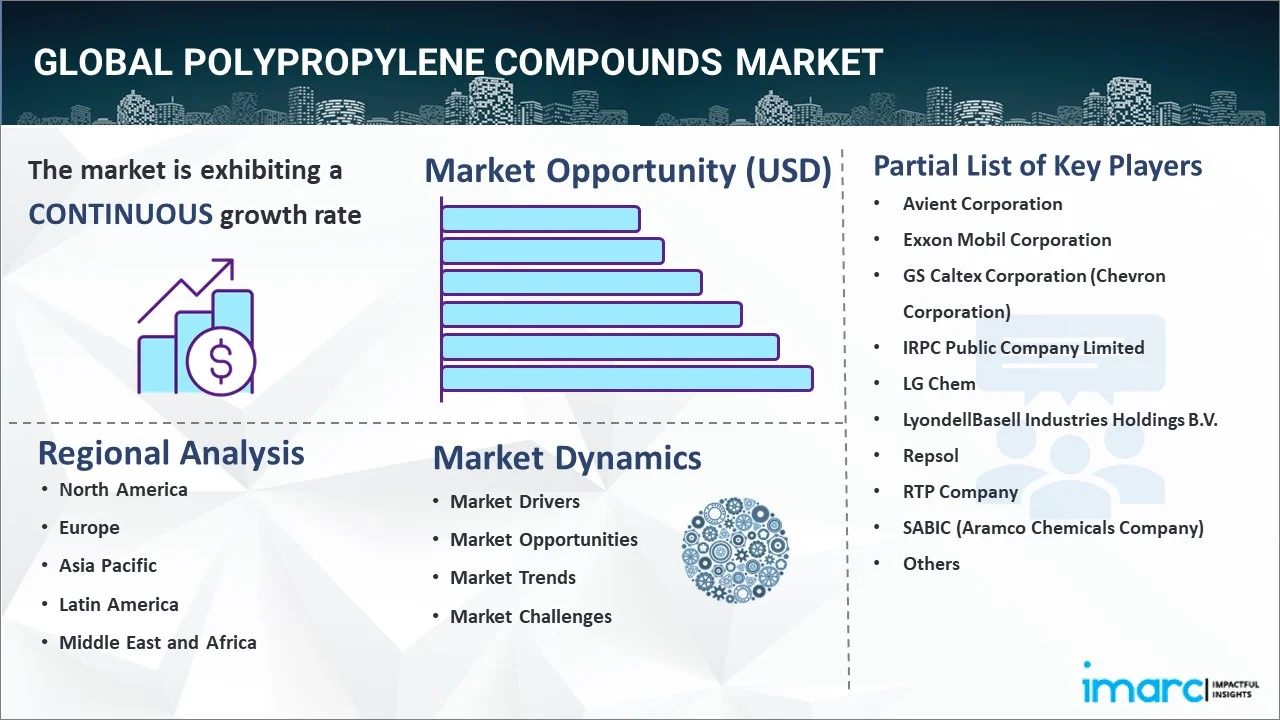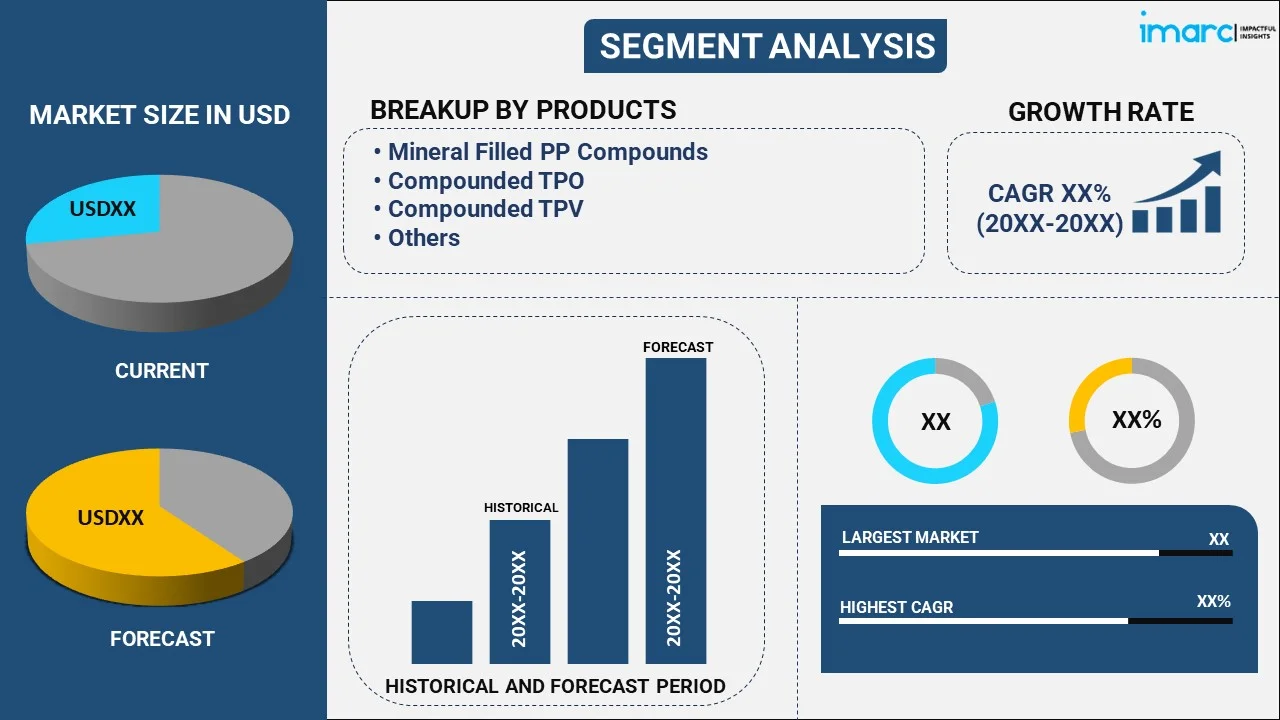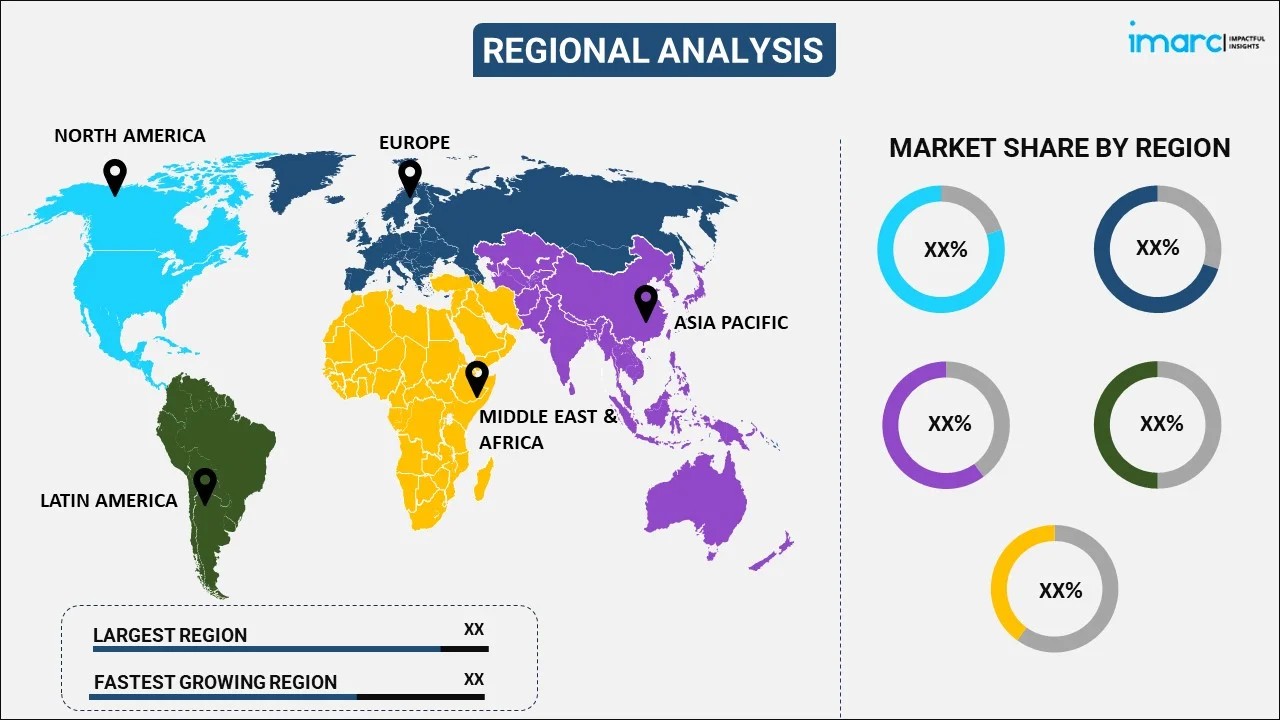
Polypropylene Compounds Market Report by Product (Mineral Filled PP Compounds, Compounded TPO, Compounded TPV, Glass Fiber Reinforced, Talc Filled and Others), Application (Fiber, Film and Sheet, Raffia, and Others), End User (Automotive, Building and Construction, Electrical and Electronics, Textile, and Others), and Region 2025-2033
Polypropylene Compounds Market Size:
The global polypropylene compounds market size reached USD 24.4 Billion in 2024. Looking forward, IMARC Group expects the market to reach USD 43.3 Billion by 2033, exhibiting a growth rate (CAGR) of 6.26% during 2025-2033. The widespread product adoption in the construction industry, significant technological advancements, and extensive research and development (R&D) activities represent some of the key factors driving the market growth.
|
Report Attribute
|
Key Statistics
|
|---|---|
|
Base Year
|
2024 |
|
Forecast Years
|
2025-2033
|
|
Historical Years
|
2019-2024
|
| Market Size in 2024 | USD 24.4 Billion |
| Market Forecast in 2033 | USD 43.3 Billion |
| Market Growth Rate (2025-2033) | 6.26% |
Polypropylene compounds are thermoplastic resins derived from the polymerization of propylene monomer. They are produced using a mixture of one or more base polyolefins with various components such as impact modifiers, fillers, strengtheners, pigments, and additives. They are widely used in automotive parts, packaging, and household appliances such as washing machines, refrigerators, and consumer goods. Polypropylene is a tough, rigid, and crystalline thermoplastic with a high melting point and exhibits excellent resistance to chemicals, moisture, and impact. They are highly durable, lightweight, versatile, and cost-effective materials that can withstand exposure to a wide range of environmental conditions. As a result, polypropylene compounds find extensive applications across the automotive, building and construction, electrical and electronics, and textile industries.

Polypropylene Compounds Market Trends:
Magnifying Demand in Automotive Lightweighting
The global polypropylene compounds market is witnessing substantial growth primarily due to the heightening requirement for lightweight materials in the automotive sector. Polypropylene compounds are rapidly being leveraged in vehicle components, such as interior trims, bumpers, and dashboards, providing better durability and reducing overall vehicle weight. Moreover, the drive for fuel efficiency and strict emissions policies has significantly expanded the polypropylene compounds market scope. In addition, the proliferating electric vehicles (EVs) segment is fueling demand, as manufacturers are actively seeking materials that can enhance performance as well as range while sustaining the structural integrity and adhering to safety standards. As per industry reports, EVs are anticipated to account for almost 50% of global car sales by the year 2030.
Expanding Product Applications in Packaging
Polypropylene compounds are experiencing magnified utilization in the packaging sector principally due to their adaptability and exceptional barrier properties. As consumer good as well as e-commerce industries are expanding globally, requirement for sustainable, effective packaging solutions is notably rising. Moreover, polypropylene compounds are generally preferred for their recyclable, durable profile and high resistance to chemicals and heat, positioning them as ideal materials for packaging applications in industrial, food, and pharmaceutical sectors. In addition, the market is profiting from advancements in both rigid and flexible packaging designs, majorly driven by sustainability objectives, where polypropylene provides a balance between environmental impact and cost efficiency. For instance, in April 2024, GEKA launched its post-consumer-recycled polypropylene for cosmetic packaging applications, minimizing carbon emissions by 75% in comparison to virgin materials. This material is comprised of 95% recycled plastic and provides cost-efficient, sustainable packaging solution.
Technological Innovations in Polypropylene Recycling
The polypropylene compounds market analysis indicates that innovations in recycling technologies is significantly favoring the market growth. Amplifying concerns regarding environmental safety and the accelerating adverse impact of increasing plastic waste have prompted advancements in polypropylene recycling, facilitating the production of excellent-quality recycled compounds suitable for a broad range of applications. According to the United Nations, globally, 430 million tons of plastic waste are generated each year. Furthermore, plastic packaging accounts for the largest share of plastic production, comprising 36%. Moreover, new technologies, such as enhanced sorting methods and chemical recycling, are significantly improving the circular economy of polypropylene, supporting the global market expansion. In addition, such advancements enable key sectors to address the sustainability targets while sustaining the material’s performance attributes, positioning recycled polypropylene compounds as a preferrable option for producers across consumer goods, automotive, and packaging industries.
Polypropylene Compounds Market Segmentation:
IMARC Group provides an analysis of the key trends in each segment of the market, along with forecasts at the global, regional, and country levels for 2025-2033. Our report has categorized the market based on product, application, and end user.
Breakup by Product:

- Mineral Filled PP Compounds
- Compounded TPO
- Compounded TPV
- Glass Fiber Reinforced
- Talc Filled
- Others
Mineral filled PP compounds account for the majority of the market share
The report has provided a detailed breakup and analysis of the market based on the product. This includes mineral filled PP compounds, compounded TPO, compounded TPV, glass fiber reinforced, talc filled and others. According to the report, mineral filled PP compounds represented the largest segment.
Breakup by Application:
- Fiber
- Film and Sheet
- Raffia
- Others
Film and Sheet holds the largest share of the industry
A detailed breakup and analysis of the market based on the application have also been provided in the report. This includes fiber, film and sheet, raffia, and others. According to the report, film and sheet accounted for the largest market share.
Breakup by End User:
- Automotive
- Building and Construction
- Electrical and Electronics
- Textile
- Others
Automotive represents the leading market segment
The report has provided a detailed breakup and analysis of the market based on the end user. This includes automotive, building and construction, electrical and electronics, textile, and others. According to the report, automotive represented the largest segment.
Breakup by Region:

- North America
- United States
- Canada
- Europe
- Germany
- France
- United Kingdom
- Italy
- Spain
- Others
- Asia Pacific
- China
- Japan
- India
- South Korea
- Australia
- Indonesia
- Others
- Latin America
- Brazil
- Mexico
- Others
- Middle East and Africa
Asia Pacific leads the market, accounting for the largest polypropylene compounds market share
The report has also provided a comprehensive analysis of all the major regional markets, which include North America (the United States and Canada); Europe (Germany, France, the United Kingdom, Italy, Spain, and others); Asia Pacific (China, Japan, India, South Korea, Australia, Indonesia, and others); Latin America (Brazil, Mexico, and others); and the Middle East and Africa. According to the report, Asia Pacific represents the largest regional market for polypropylene compounds. Some of the factors driving the Asia Pacific polypropylene compounds market included the widespread product adoption in the automotive industry, significant technological advancements, and increasing expenditure capacities of consumers.
Competitive Landscape:
The report has also provided a comprehensive analysis of the competitive landscape in the global polypropylene compounds market. Competitive analysis such as market structure, market share by key players, player positioning, top winning strategies, competitive dashboard, and company evaluation quadrant has been covered in the report. Also, detailed profiles of all major companies have been provided. Some of the companies covered include:
- Avient Corporation
- Exxon Mobil Corporation
- GS Caltex Corporation (Chevron Corporation)
- IRPC Public Company Limited
- LG Chem
- LyondellBasell Industries Holdings B.V.
- Repsol
- RTP Company
- SABIC (Aramco Chemicals Company)
- TotalEnergies
- Trinseo S.A.
- Washington Penn
Kindly note that this only represents a partial list of companies, and the complete list has been provided in the report.
Polypropylene Compounds Market News:
- In December 2023, Nayara Energy announced plans to initiate the development of a propylene plant in Q1 2024, expanding its footprint in the petrochemical industry. The plant will have annual production capacity of 4,50,000 tons.
- In September 2024, Tri-Tech 3D launched SAF polypropylene, particularly manufactured for the Stratasys H350 powder bed fusion additive manufacturing system. This material allows the manufacturing of large-scale, production-grade polypropylene parts, providing exceptional lightweight attributes and high chemical resistance.
Polypropylene Compounds Market Report Scope:
| Report Features | Details |
|---|---|
| Base Year of the Analysis | 2024 |
| Historical Period | 2019-2024 |
| Forecast Period | 2025-2033 |
| Units | Billion USD |
| Scope of the Report | Exploration of Historical Trends and Market Outlook, Industry Catalysts and Challenges, Segment-Wise Historical and Future Market Assessment: ·
|
| Products Covered | Mineral Filled PP Compounds, Compounded TPO, Compounded TPV, Glass Fiber Reinforced, Talc Filled, Others |
| Applications Covered | Fiber, Film and Sheet, Raffia, Others |
| End Users Covered | Automotive, Building and Construction, Electrical and Electronics, Textile, Others |
| Regions Covered | North America, Europe, Asia Pacific, Latin America, Middle East and Africa |
| Countries Covered | United States, Canada, Germany, France, United Kingdom, Italy, Spain, China, Japan, India, South Korea, Australia, Indonesia, Brazil, Mexico |
| Companies Covered | Avient Corporation, Exxon Mobil Corporation, GS Caltex Corporation (Chevron Corporation), IRPC Public Company Limited, LG Chem, LyondellBasell Industries Holdings B.V., Repsol, RTP Company, SABIC (Aramco Chemicals Company), TotalEnergies, Trinseo S.A., Washington Penn, etc. |
| Customization Scope | 10% Free Customization |
| Post-Sale Analyst Support | 10-12 Weeks |
| Delivery Format | PDF and Excel through Email (We can also provide the editable version of the report in PPT/Word format on special request) |
Key Questions Answered in This Report:
- How has the global polypropylene compounds market performed so far, and how will it perform in the coming years?
- What are the drivers, restraints, and opportunities in the global polypropylene compounds market?
- What is the impact of each driver, restraint, and opportunity on the global polypropylene compounds market?
- What are the key regional markets?
- Which countries represent the most attractive polypropylene compounds market?
- What is the breakup of the market based on the product?
- Which is the most attractive product in the polypropylene compounds market?
- What is the breakup of the market based on the application?
- Which is the most attractive application in the polypropylene compounds market?
- What is the breakup of the market based on the end user?
- Which is the most attractive end user in the polypropylene compounds market?
- What is the competitive structure of the market?
- Who are the key players/companies in the global polypropylene compounds market?
Key Benefits for Stakeholders:
- IMARC’s industry report offers a comprehensive quantitative analysis of various market segments, historical and current market trends, market forecasts, and dynamics of the polypropylene compounds market from 2019-2033.
- The research report provides the latest information on the market drivers, challenges, and opportunities in the global polypropylene compounds market.
- The study maps the leading, as well as the fastest-growing, regional markets. It further enables stakeholders to identify the key country-level markets within each region.
- Porter's five forces analysis assists stakeholders in assessing the impact of new entrants, competitive rivalry, supplier power, buyer power, and the threat of substitution. It helps stakeholders to analyze the level of competition within the polypropylene compounds industry and its attractiveness.
- The competitive landscape allows stakeholders to understand their competitive environment and provides insight into the current positions of key players in the market.
Need more help?
- Speak to our experienced analysts for insights on the current market scenarios.
- Include additional segments and countries to customize the report as per your requirement.
- Gain an unparalleled competitive advantage in your domain by understanding how to utilize the report and positively impacting your operations and revenue.
- For further assistance, please connect with our analysts.
 Request Customization
Request Customization
 Speak to an Analyst
Speak to an Analyst
 Request Brochure
Request Brochure
 Inquire Before Buying
Inquire Before Buying




.webp)




.webp)












